The The role of family environment and learning motivation in the dropout phenomenon among students in Eastern Indonesia border regions
DOI:
https://doi.org/10.55942/pssj.v5i8.554Keywords:
Family Environment, Learning Motivation, School DropoutAbstract
This study examines the role of learning motivation as a mediating variable in the relationship between the family environment and the phenomenon of school dropout in the Indonesian-Timor Leste border area. A quantitative approach was used as the explanatory research method. The population in this study comprised high school/vocational school students who dropped out of school in the Malacca Regency, East Nusa Tenggara. A sample of 120 respondents from 12 sub-districts was obtained through proportional sampling techniques. Data collection was carried out through questionnaires and data analysis using Path Analysis with the help of the SPSS 27. The results showed that family environment had a significant effect on learning motivation, with a score of 9.676 and a significance value of 0.001. Family environment had a significant effect on school dropouts, which was calculated to be 4.312 and a significance value of 0.001. Learning motivation had a significant effect on school dropouts, with a score of 4.465 and significance value of 0.001. Learning motivation was able to mediate the influence of the family environment on school dropouts, with an indirect effect of -1,048, and the Sobel test score = 12,467 > t table = 1,658; thus, the mediation was significant. This study concluded that a positive family environment can increase learning motivation and indirectly reduce the risk of dropping out of school. These findings have important implications for education policies in border areas.
References
Alivernini, F., & Lucidi, F. (2011). Relationship between social context, self-efficacy, motivation, academic achievement, and intention to drop out of high school: A longitudinal study. Journal of Educational Research, 104(4), 241–252. https://doi.org/10.1080/00220671003728062
Anttila, S., Lindfors, H., Hirvonen, R., Määttä, S., & Kiuru, N. (2023). Dropout intentions in secondary education: Student temperament and achievement motivation as antecedents. Journal of Adolescence, 95(2), 248–263. https://doi.org/10.1002/jad.12110
Arsita, E., Syafruddin, S., & Ilyas, M. (2022). Anak Putus Sekolah (Studi Di Masyarakat Desa Seteluk Kabupaten Sumbawa Barat). Jurnal Pendidikan Sosial Keberagaman, 9(1), 43–48. https://doi.org/10.29303/juridiksiam.v9i1.182
Asif, M., Hayat, M., & Khan, S. (2021). Factors associated to High School Students Dropout in Mala-kand District Pakistan. Business, Economics and Management. https://doi.org/10.20944/preprints202105.0611.
Buizza, C., Cela, H., Sbravati, G., Bornatici, S., Rainieri, G., & Ghilardi, A. (2024). The Role of Self-Efficacy, Motivation, and Connectedness in Dropout Intention in a Sample of Italian College Students. Education Sciences, 14(1). https://doi.org/10.3390/educsci14010067
Chenge, R. P., Chenge, E., & Maunganidze, L. (2017). Family Factors that contribute to school dropout in Rushinga District in Zimbabwe. International Journal of Law, 1(4), 105.
Consoni, C., Pesce, C., & Cherubini, D. (2021). Early drop-out from sports and strategic learning skills: A cross-country study in Italian and Spanish students. Sports, 9(7), 1–13. https://doi.org/10.3390/sports9070096
Guzmán, A., Barragán, S., & Cala Vitery, F. (2021). Dropout in Rural Higher Education: A Systematic Review. Frontiers in Education, 6(September), 1–14. https://doi.org/10.3389/feduc.2021.727833
Hernawati, R., Butar-butar, A., Purba, S. E. E., & Nes, A. C. (2025). Edukasi Pentingnya Melanjutkan Pendidikan Tinggi: Program Peningkatan Kesadaran Studi Sarjana bagi Siswa Sekolah Menengah di Perbatasan Indonesia - Timor Leste. Diakoneo: Jurnal Pengabdian Kepada Masyarakat, 1(2), 124–134.
Kurniawan, F., Yeni Erita, Didi Syahrir, & Vani Qhairum Nisa Utami. (2023). The influence of students’ environment on students’ learning motivation. Journal of Digital Learning and Distance Education, 1(8), 297–305. https://doi.org/10.56778/jdlde.v1i8.58
Lanz, M., & Maino, E. (2023). Family Environment Scale. Encyclopedia of Quality of Life and Well-Being Research. https://doi.org/10.1007/978-3-031-17299-1_999
Lawrence, K. C., & Adebowale, T. A. (2023). Adolescence dropout risk predictors: Family structure, mental health, and self-esteem. Journal of Community Psychology, 51(1), 120–136. https://doi.org/10.1002/jcop.22884
Luo, B. (2024). How Family Environment Affects Students’ Academic Performance. Lecture Notes in Education Psychology and Public Media, 49(1), 89–94. https://doi.org/10.54254/2753-7048/49/20231802
Marlina, S., Rahmawati, A., & . I. (2018). The Effect of Teacher’s Competency, Physical Environment of Classroom and Family Environment Towards Students’ Learning Motivation. KnE Social Sciences, 3(10), 224. https://doi.org/10.18502/kss.v3i10.3131
Morelli, M., Chirumbolo, A., Baiocco, R., & Cattelino, E. (2023). Self-regulated learning self-efficacy, motivation, and intention to drop-out: The moderating role of friendships at University. Current Psychology, 42(18), 15589–15599. https://doi.org/10.1007/s12144-022-02834-4
Neupane, B. (2024). Causes of Dropout in Higher Education: An Analysis of Student Dropouts in Bachelor of Education from Marsyangdi Multiple Campus. Marsyangdi Journal, 4(July), 1–14. https://doi.org/10.3126/mj.v4i1.67750
Nurmalitasari, Awang Long, Z., & Faizuddin Mohd Noor, M. (2023). Factors Influencing Dropout Students in Higher Education. Education Research International, 2023. https://doi.org/10.1155/2023/7704142
Oliveira, C. F. De, Sobral, S. R., Ferreira, M. J., & Moreira, F. (2021). How does learning analytics contribute to prevent students’ dropout in higher education: A systematic literature review. Big Data and Cognitive Computing, 5(4). https://doi.org/10.3390/bdcc5040064
Putrik, P., Kant, I. J., Hoofs, H., Reijs, R., & Jansen, M. J. (2024). Prediction of School Dropout Outside School Setting: Potential for Early risk Stratification by Youth Health Care Services in the Netherlands. Results from a Retrospective Cohort Study. Child and Youth Care Forum, 53(2), 349–365. https://doi.org/10.1007/s10566-023-09757-6
Roman, N. V., Davidse, P. E., Human-hendricks, A., Butler-kruger, L., & Sonn, I. K. (2022). School Dropout : Intentions , Motivations and Self-Efficacy of a Sample of South Africa Youth. Youth, 2, 126–137.
Rump, M., Esdar, W., & Wild, E. (2017). Individual differences in the effects of academic motivation on higher education students’ intention to drop out. European Journal of Higher Education, 7(4), 341–355. https://doi.org/10.1080/21568235.2017.1357481
Ryan, R. M. (2019). The Oxford Handbook of Human Motivation. Oxford University Press.
Sauri, M. S., Purnomo, Y. W., & Mustadi, A. (2022). Analysis of Student Learning Motivation using Project-Based Learning Method. 14(2021), 3405–3412. https://doi.org/10.35445/alishlah.v14i3.665
Sivakumar, S., Venkataraman, S., & Selvaraj, R. (2016). Predictive modeling of student dropout indicators in educational data mining using improved decision tree. Indian Journal of Science and Technology, 9(4), 1–5. https://doi.org/10.17485/ijst/2016/v9i4/87032
Sorensen, L. C. (2019). “Big Data” in Educational Administration: An Application for Predicting School Dropout Risk. Educational Administration Quarterly, 55(3), 404–446. https://doi.org/10.1177/0013161X18799439.
Downloads
Published
How to Cite
Issue
Section
License
Copyright (c) 2025 Retno Hernawati, Maria Yuliana Panie, Samrid Neonufa, Al Ihzan Tajuddin

This work is licensed under a Creative Commons Attribution 4.0 International License.

















